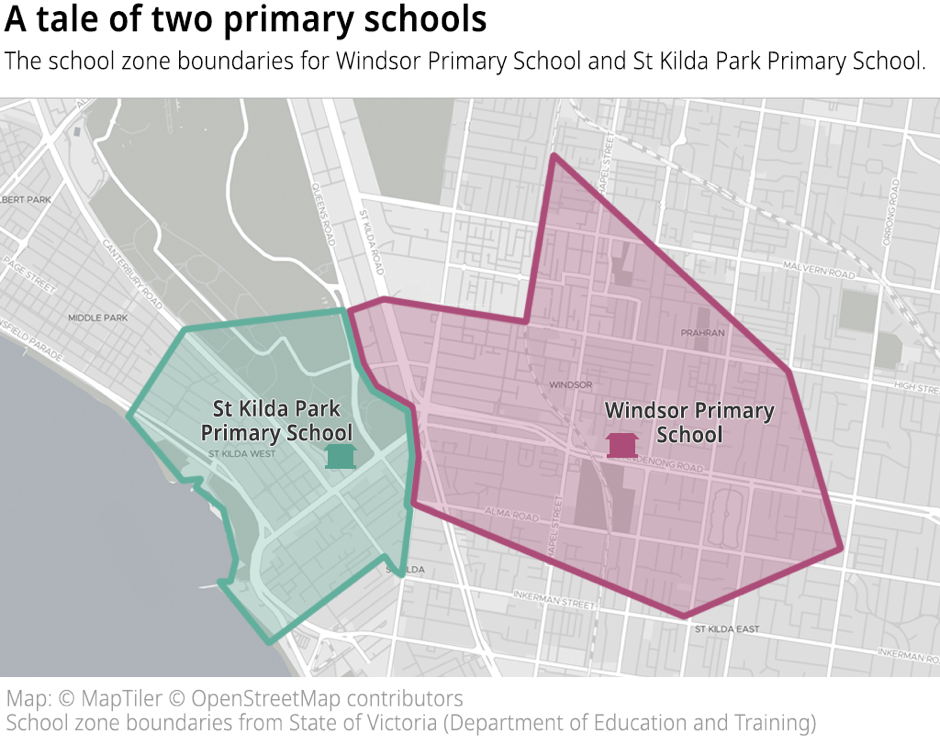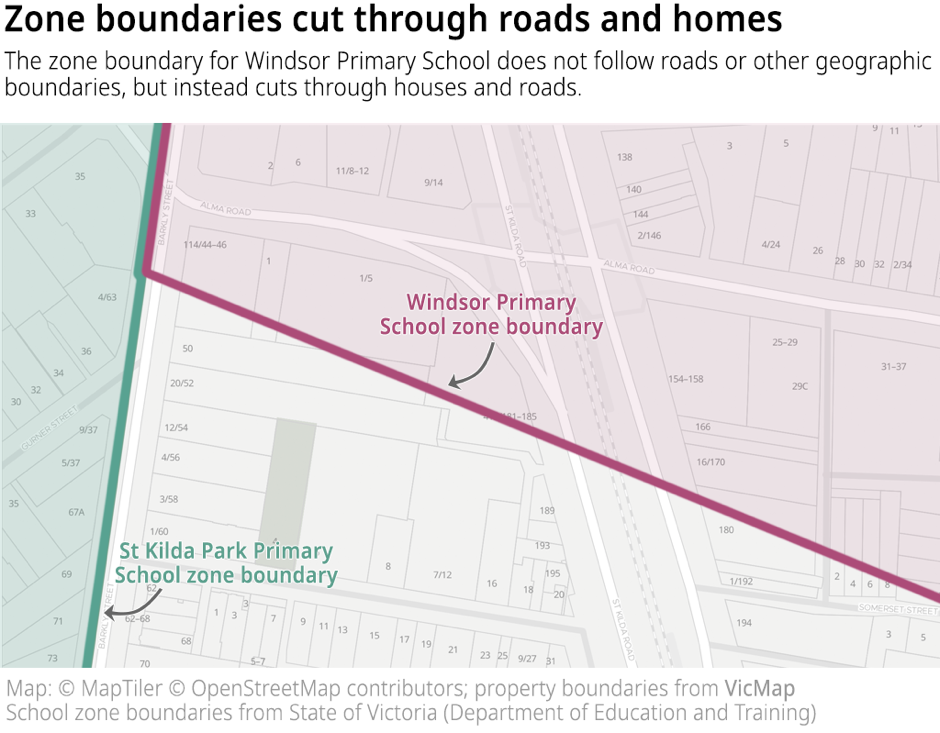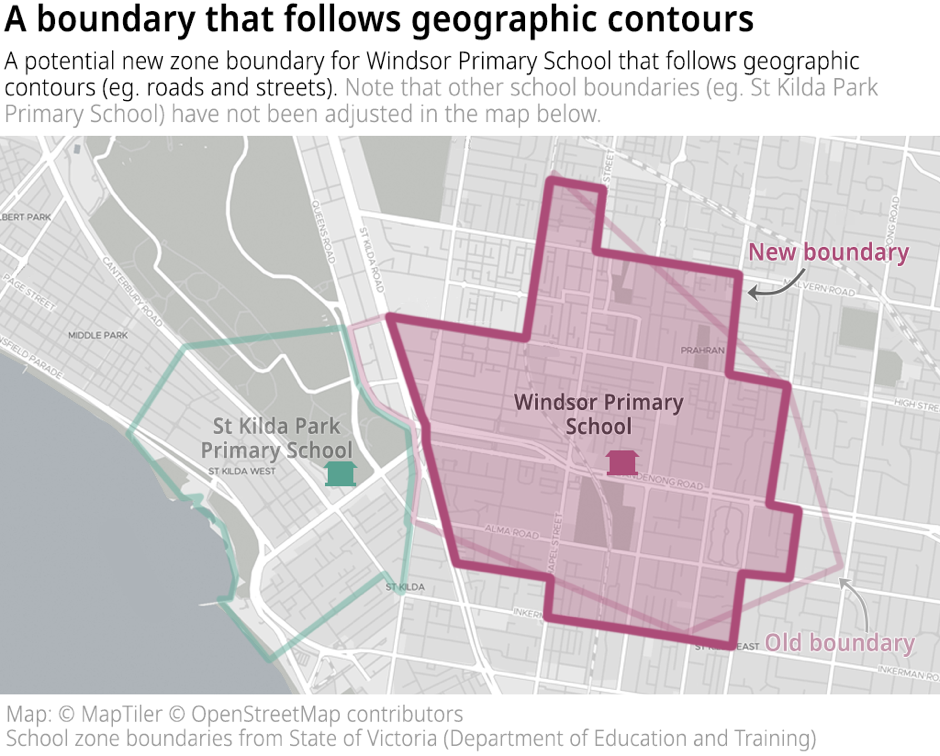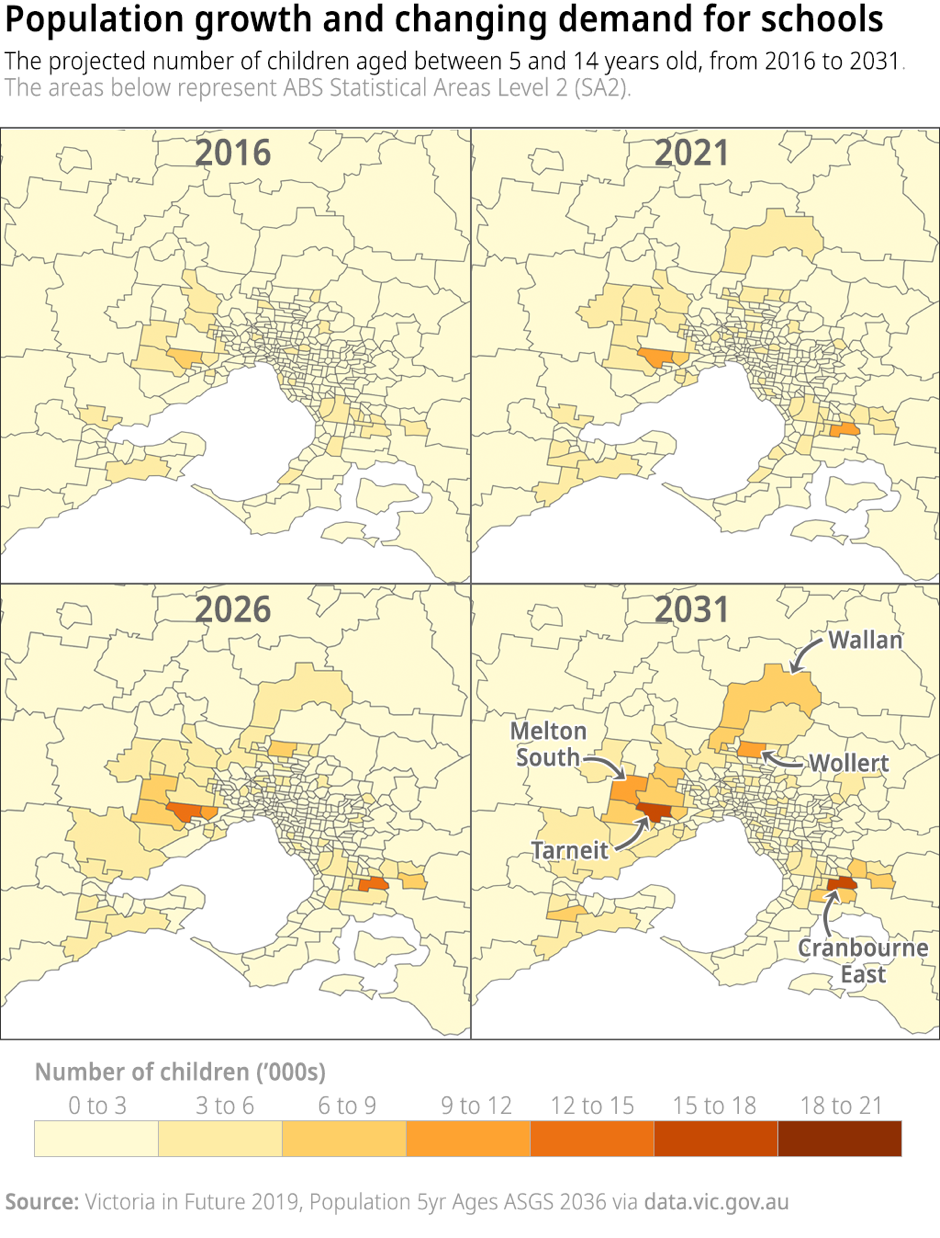Contact us
First Floor, 159 Victoria Pde
Collingwood, VIC 3066
(Google Map)
1300 727 952
or
+61 3 9910 4099
Open Data Insights #2:
Victorian School Zones
The Victorian school zone boundaries have been released as a geographic dataset for the first time, and were part of a GovHack challenge. In this Open Data Insight, we look at some of the issues with the current zones that can result in suboptimal and odd zone boundaries, which can be problematic for both students and schools alike.
A challenge to improve school zones
Choosing the right school for your child can be a difficult decision. Firstly, there’s the decision of choosing the type of school — government, independent or religious. And if you do decide to send your child to a great government school nearby, the issue then becomes whether you live within that school’s zone.
All government primary and secondary schools have enrolment zones. These zones define the designated schools for students based on their permanent residential address. In Victoria, all children are entitled to be enrolled at their designated neighbourhood school as a right under the legislation. (Note that specialist schools and schools with specific enrolment criteria including English language schools and select entry schools do not have associated enrolment zones.)
In this Open Data Insight, we’re going to look at Victorian school zones data, which has been released as a spatial (geographic) dataset for the first time by the Department of Education and Training via data.vic.gov.au.
This dataset is part of a GovHack challenge, and we’re going to look at some of the issues the Department of Education and Training is hoping “hackers” — you perhaps? — can help solve.
Closest is not always the best
In metropolitan Melbourne (and in the major regional areas of Ballarat, Bendigo and Geelong), school zone boundaries are determined by voronoi polygons. This effectively defines a school’s zone such that all houses within a school’s zone are closest to that school, and not to another school.
But the issue with voronoi polygons is that “closeness” is measured in a straight line from the house to the school, and does not consider the roads, bicycle paths or public transport routes the child would typically use.
Note, however, outside of metropolitan Melbourne, Ballarat, Bendigo and Geelong, roads are factored when determining boundaries and the shortest practical route is used to determine school zones. And in some cases, physical barriers (e.g. creeks, major roads, train tracks, etc.) are taken into consideration when defining a school zone to allow for easier accessibility.
But for the majority of schools, the boundaries are not optimally defined (though, as we’ll see below, it’s rather difficult to determine what optimal actually is).
Take, for example, Windsor Primary and St Kilda Park Primary schools.
The 2020 school zone boundaries for Windsor Primary School and St Kilda Park Primary School.
A child living at 22 Alma Rd would technically be closer (as the crow flies) to St Kilda Park Primary. (And even when taking roads into account, it’s an 11-minute walk as opposed to 18 minutes to Windsor Primary.) But to get there, he or she would have to cross the Nepean Highway (St Kilda Rd). So it seems sensible they’re allocated to Windsor Primary School, which is how that child’s house is currently zoned. But Windsor Primary is an 18-minute walk, and there’s still a busy intersection (Dandenong Rd) to negotiate.
A possible walking route for a student living at 22 Alma Rd to Windsor Primary School - their designated school (about an 18-minute walk). The student’s nearest school would be St Kilda Park Primary (about a 10-minute walk), but requires crossing the major intersection of Nepean Highway.
What about their friends who live at 36 Barkly St? They’re also zoned to Windsor Primary, but because they’re on the other side of the Nepean Highway, they do have to cross the large, busy intersection to get to their school, which is a 20-minute walk away (according to Google Maps). Whereas St Kilda Park Primary would only be an easy 10-minute walk, without a major intersection in the way.
A school boundary through a bedroom?
A related issue with defining zones based on voronoi polygons is that the actual boundaries do not follow natural geographic contours such as roads or train lines, resulting in boundaries that run through the middle of a street, or even a house! So two children living in neighbouring houses may be allocated to two different schools.
The map below showing a zoomed-in section of Windsor Primary School zone illustrates this point.
A zoomed-in map of Windsor Primary School zone showing how the boundary cuts through properties and roads.
It would be far more logical for households (and schools) if zone boundaries followed roads or other prominent geographic contours.
A redrawn map of Windsor Primary School zone with the boundary following road contours (that is, the boundary does not cut through roads or properties).
Fair for both schools and students
There are, however, more things to consider when determining school zones than avoiding busy roads and following logical boundaries.
One of the most important factors when zoning is to ensure the number of children within a school’s zone roughly matches the school’s capacity to accommodate the potential demand. But these numbers will continually change. Victoria’s population is growing, but some suburbs will grow much faster and by a greater amount than others, while other suburbs will see a decline in the school-aged population.
And this raises another issue with the current implementation of school zones: they do not align current or projected student demand to a school’s size or capacity.
Using population estimates from Victoria in Future 2019, we can see that some of the outer suburbs, particularly Cranbourne East and Tarneit, are projected to have significant growth in school-aged children between 2016 to 2036.
Estimated growth in the number of Victorian children aged between 5 and 14, from 2016 to 2031 in five year intervals. The outer western, eastern and northern regions are projected to have the most growth, with Tarneit (in the west) and Cranbourne East (in the east), estimated to have the most growth during this period.
The number of children aged between five and 14 in Tarneit is expected to increase from 6,165 in 2016 to 10,167 by 2021 (and 17,836 by 2036!). Cranbourne East will have a similar but even more dramatic growth, with the number of children aged between five and 14 increasing from 4,356 in 2016 to 9,612 in 2021 and climbing to 19,180 by 2036.
Clearly the capacity of schools in these areas will need to increase, and perhaps new schools will also be needed. But the question becomes how do school zones change to reflect changing demand for school places, and the capacity of schools to meet this demand?
A dataset not just for parents, students and schools
Apart from schools, parents and students, a number of businesses and organisations use school zone information in their products and services. And now, they can rely on an authoritative data source instead of manually capturing and maintaining their own zones.
For example, real estate advertising businesses such as Domain.com.au and realestate.com.au list the nearest schools to a property. The Domain website even shows the catchment zone for a particular school — important information for potential buyers and renters in Victoria (as parents who desperately buy or rent within Balwyn High or Northcote High school zones know only too well).
Take up the challenge
Hopefully, some of the issues we have examined with the Victorian school zones were addressed by the teams tackling this GovHack challenge. And you might wish to explore the school zones data in more detail, and uncover other shortcomings, along with possible solutions.
If you do, we’d love to hear from you!
Find out more about this dataset and other education-related information from the Department of Education and Training. Details below:
Website: https://www.education.vic.gov.au/
Twitter: @DETVic
LinkedIn: https://www.linkedin.com/company/detvic/
See any errors or issues? Please let us know.




